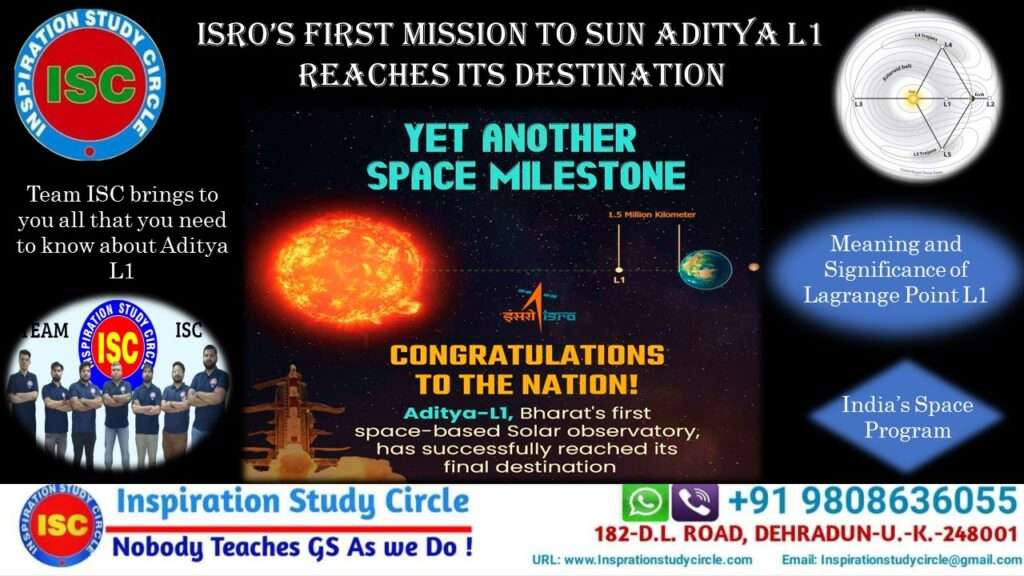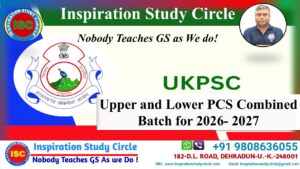
The Viksit Bharat – Guarantee for Rozgar and Ajeevika Mission (Gramin) Bill, 2025
The Viksit Bharat – Guarantee for Rozgar and Ajeevika Mission (Gramin) Bill, 2025 Table of Contents The Viksit Bharat – Guarantee
Aditya L1 UPSC 2024, Aditya L1 UPPCS 2024, Aditya L1 Lagrange Points UPSC 2024, L1 UPSC 2024
In the recent state of affairs, India has achieved, yet another milestone in its highly focused Space Program. Aditya-L1, India’s first solar observation satellite, has reached its designated orbit at Lagrange Point 1, successfully. This splendid streak took place on Saturday, 6th Jan, 2024. Months after its successful launch, Aditya L-1 entered into the halo orbit around Lagrange Point 1. After this historic triumph, Prime Minister Narendra Modi took to X and congratulated ISRO for this important achievement.
“India creates yet another landmark. India’s first solar observatory Aditya-L1 reaches its destination. It is a testament to the relentless dedication of our scientists in realizing the most complex and intricate space missions. I join the nation in applauding this extraordinary feat. We will continue to pursue new frontiers of science for the benefit of humanity,” he wrote on X.
Following the successful entry of Aditya L1 into the designated orbit by Aditya L1, ISRO confirmed the successful completion of the mission in a recent tweet, now X.
“𝐈𝐧𝐝𝐢𝐚, 𝐈 𝐝𝐢𝐝 𝐢𝐭. 𝐈 𝐡𝐚𝐯𝐞 𝐫𝐞𝐚𝐜𝐡𝐞𝐝 𝐭𝐨 𝐦𝐲 𝐝𝐞𝐬𝐭𝐢𝐧𝐚𝐭𝐢𝐨𝐧! Aditya-L1 has successfully entered the Halo orbit around the L1 point,” wrote ISRO on X.

Lagrange Points are points where the gravitational attraction of two large masses is exactly equal to the centrifugal force required to move a small object with them. These points in space can be used by spacecraft to reduce the fuel consumption required to stay in position. It is named after the 18th-century Italian-French mathematician Joseph-Louis Lagrange. This mathematical problem is known as the General Three-Body Problem.
L3 lies beyond the Sun, opposite the Earth, beyond the orbit of our planet. In L3, the object cannot be seen from the foreground. No benefit can be found for point L3 as it is always hidden behind the Sun.
L4 and L5 have large collections of interstellar dust and asteroids known as Trojans. Space scientists are also exploring the potential of the L4 and L5 nodes to host space colonies. This point is closer to Earth, so a spacecraft will need very little fuel to stay in orbit or fly to another planet.
Halo Orbit: A halo orbit is a three-dimensional orbital path that repeats itself in the context of a three-body problem in orbital mechanics that is located near one of the Lagrange points, typically L1, L2, or L3.
L1 is the sweet spot – about 1.5 million km from Earth and about 148.5 million km from the Sun – where the gravitational pull between the Sun and Earth is perfectly balanced.
Astrophysicists from ISRO and India have so far studied the Sun from before. Ground observation surveys have two limitations – they can only be done from dawn to dusk, and dust particles in the atmosphere distort the survey results. To ensure the exploration of the Sun, ISRO decided to launch a payload into space at Lagrange Point 1 in 2013.
In the words of Prof. Ramesh R from the Indian Institute of Astrophysics (IIA), in Bengaluru, “When you say L1 point, if you consider the solar system with sun and Earth as massive bodies, there are five vantage points where gravitational forces between these two are perfectly balanced. These five points are called Lagrange points as they were first invented by Italian astronomer Joseph Lagrange, so L1 is in a straight line with the sun and Earth. It’s a gravitational stable point with an uninterrupted view of the sun. Any scattering due to dust is also taken care of since you are going well above the earth. That’s one of the reasons why the mission was designed.”
| Type | Sl.No | Payload | Capability | Laboratories |
| Remote Sensing Payloads | 1 | Visible Emission Line Coronagraph (VELC) | Corona Imaging and Spectroscopy | Indian Institute of Astrophysics, Bangalore |
| 2 | Solar Ultraviolet Imaging Telescope (SUIT) | Photosphere and chromosphere imaging-narrow and broadband | Inter-University Centre for Astronomy & Astrophysics, Pune | |
| 3 | Solar Low Energy X-ray Spectrometer (SoLEXS) | Soft X-ray spectrometer: Sun-as-a-star observation | U R Rao Satellite Centre, Bangalore | |
| 4 | High Energy L1 Orbiting X-ray Spectrometer(HEL1OS) | Hard X-ray spectrometer: Sun-as-a-star observation | ||
| In-situ Payloads | 5 | Aditya Solar Wind Particle Experiment (ASPEX) | Solar wind and Particle analyzer: Protons and Heavier ions with directions | Physical Research Laboratory, Ahmedabad |
| 6 | Plasma Analyser Package For Aditya (PAPA) | Solar wind and Particle Analyzer: Electrons and Heavier Ions with directions | Space Physics Laboratory, Vikram Sarabhai Space Centre, Thiruvananthapuram | |
| 7 | Advanced Tri-axial High-Resolution Digital Magnetometers | In-situ magnetic field (Bx, By and Bz). | Laboratory for Electro-Optics Systems, Bangalore |
Visible Emission Line coronagraph (VELC): Visible Emission Line Coronagraph (VELC) is a key instrument in India’s Aditya-L1 space solar mission. VELC is an internal occultation reflective coronagraph designed to meet specific surveillance needs. This device allows for high-resolution imaging of the Sun’s corona, simultaneous observation in three modes (Imaging, Spectroscopy, and Spectro-polarimetry), and even uses artificial intelligence to help detect coronal mass ejections (CMEs).
Solar Ultraviolet Imaging Telescope (SUIT): SUIT is an ultraviolet imaging telescope designed to study solar spectral radiation in the ultraviolet range using narrow- and broadband spectral filters in the 200-400 nm range, with the hope of better understanding the relationship between solar activity and the dynamics of the Earth’s atmosphere. SUIT covers the sun’s atmosphere simultaneously from the lower photosphere to the upper chromosphere. The instrument was developed by the Center for Astronomy and Astrophysics at the University of Internazionale (lUCAA), in collaboration with ISRO.
Solar Low Energy X-ray Spectrometer (SoLEXS): SoLEXS is an X-ray spectrometer designed to continuously measure the solar soft X-ray flux from the Sun-Earth Lagrangian L1 point. These measurements can be used to better understand the properties of the Sun’s corona, specifically why the corona is so hot. SoLEXS will observe solar flares and, together with data from VELC, help study the complex thermal properties of the Sun’s outer layers.
Launch Year | Launch Date | Satellites/Events |
2024 | 01st Jan | |
2023 | 02nd Sep | The Launch of Aditya-L1 by PSLV-C57 was accomplished successfully |
23rdAug | Chandrayaan-3 mission successfully soft-landed on Moon and Chandrayaan-3 Rover ramped down from the lander. | |
14thJuly | LVM3 M4 vehicle successfully launched Chandrayaan-3 into orbit | |
29th May | ||
10th Feb | ||
2022 | 26th Nov | |
23rd Jun | ||
14th Feb | PSLV-C52 successfully launches EOS-04 and two co-passenger satellites from Sriharikota |

The Viksit Bharat – Guarantee for Rozgar and Ajeevika Mission (Gramin) Bill, 2025 Table of Contents The Viksit Bharat – Guarantee

How to Prepare for UKPCS 2026 in Six Months Table of Contents ISC- How to Prepare for UKPCS 2026 in

UKPSC Upper and Lower PCS Combined Batch for 2026-2027 Table of Contents Unlocking Uttarakhand’s Civil Services: The Power of UKPCS

Explained: Russian President Vladimir Putin’s State Visit to India Table of Contents Russian President Vladimir Putin conducted a state visit

UPPSC Upper PCS 2025: Mains Test Series and Answer Writing Table of Contents Inspiration Study Circle- Dehradun The UPPSC PCS

The Sanchar Saathi App Table of Contents The Sanchar Saathi app is a security and user-protection platform developed by India’s Department of Telecommunications (DoT) to help users manage mobile connections, report fraud, and locate lost phones